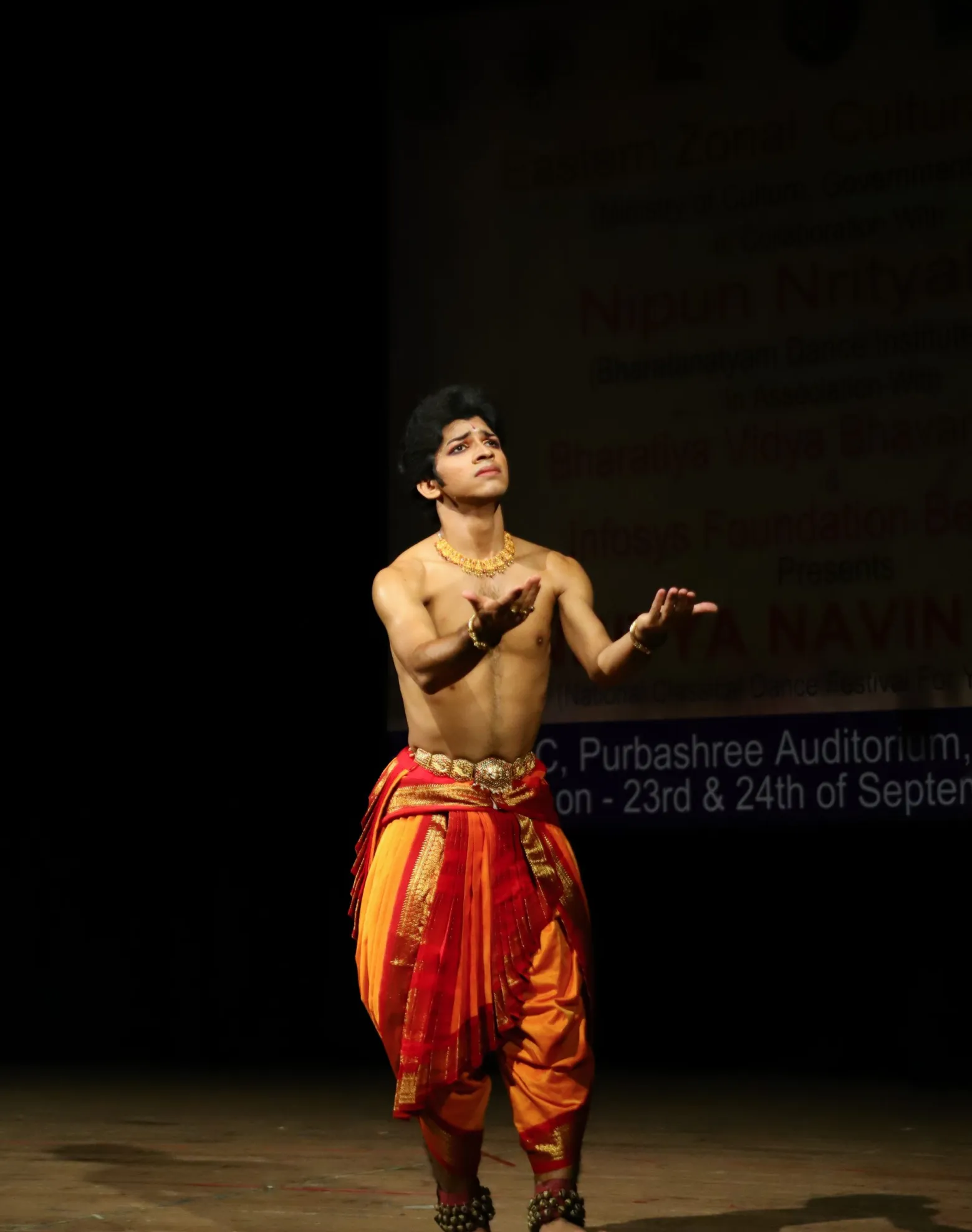Feature by yashasvi Anika Tandon
India is a country with many beautiful classical dances.
Why don’t we learn about them? Let’s learn about one of them today – Bharatnatyam.
The word Bharat-Natyam means – Theater of India. Like a theater artiste, the Bharat-Natyam dancer brings a story alive for the viewers.

Like all Indian classical dance forms, the origin of the dance was to tell important stories to devotees in a temple or religious gathering.
History of Bharatanatyam
Bharatanatyam’s first trace is in Sage Bharat’s Natya Shastra. All classical dances of India are said to originate from this rich book that has guidelines on how to enact, pose, or emote during a story performance.
It is also based on Nandikesvar’s Abhinaya Darpana.
About 2,000 years ago, Bharatanatyam was first performed by Devadasis (women who worked in temples as priestesses). Years of training was required to make one’s first public performance.
For any Bharatanatyam dancer, the first public performance, called Arangetram, is considered very special. It is only possible after the guru is certain that the student has learnt enough to perform in public.

Bharatanatyam was also called Dasiattam because the Devdasis brought it to life. Poses of Bharatanatyam, carved on stones and pillars, have been discovered in ancient South-Indian temples.
The Gopuram (south-Indian temple-top that tapers at the top – figures are usually made on it) of the Chidambaram Temple in Tamil Nadu has several Bharatanatyam poses.

At the Brihadeeswara Temple in Thanjavur, Bharatanatyam has been performed since 1,000 CE. Bharatanatyam in temples became uncommon as the British did not support it. E. Krishna Iyer struggled to revive Bharatanatyam in temples during the British Rule. Bala Saraswati and Rukmini Devi Arunadale supported his struggle to revive Bharatanatyam. They promoted Bharatanatyam to be done in places outside temples as well. Bharatanatyam’s old names are Sadir Attam, and Thevarattam.
Let’s check out the dressing in Bharatanatyam

The traditional dress of Bharatnatyam is a saree. Today, dancers wear a blouse, a dupatta, and a skirt. There are 2 kinds of skirts. One that is like a simple skirt. The other kind is a skirt that is pleated to look like a fan.
As upper wear, men wear a simple necklace only. They wear skirts as well. Both men and women wear jewellery in Bharatanatyam. Makeup is also done to highlight facial expressions. Both men and women wear ghungroos (bells strung on a rope which is worn and wound two to three times around the ankles).
The highlight of the dress is the heavy temple jewelry. This jewelry is now famous.
Features of Bharatanatyam
Bharatanatyam consists of 3 main features:
- Nritta
- Natya
- Nrithya
Nritta – Nritta is pure dance that includes Adavus, which is the rhythmic combination of footwork accompanied with hand and body movements. It stresses on Bhava (sentiment), and Rasa (emotion). Bharata Muni has described 49 Bhavas, and 8 Rasas in Natya Shastra.
Examples – Thillana and Jaliswaram
Natya – Natya consists of facial expressions, and hastas (hand movements). The dancer uses Natya to describe the song.
Examples – Shabdam, Jawali, and Padam
Nrithya – Nrithya is basically a combination of Nritta, and Natya. It includes footwork, hand and body movements, facial expressions, and hastas.
Examples – Swajarathi, and Pada Varnam
Banis or Styles of Dance
Bharatanatyam mainly has 4 styles or banis:
Pandanallur Style
Vazhuvoor Style
Kalakshetra Style
Melattur Style
Pandanallur Style
Guru Meenakshi Sundaram Pillai, who lived in Pandallur, founded the Pandallur style of Bharatanatyam. It concentrates on the formation of angles of 45 degree, 90 degree, 180 degree, etc, in hand, and body movements.
Vazhuvoor Style
The Vazhuvoor style was founded by Vazhuvoor Ramai Pillai. It stresses on elegant poses, graceful and swift dance moves, and absorbing eye movements. Rhythmic patterns or Jatis form an important part of the Vazhuvoor Style of Bharatanatyam.
The dancer leaps gracefully while doing jatis.
Kalakshetra Style
The Kalakshetra style was founded by Rukmini Devi Arundale. It was her style of dance so she wanted to preserve it. It concentrates on straight, angular, ballet-like kinesthetics (the feeling of hand, leg, and body movements).
Melattur style
The Melattur style was founded by Mangudi Dorairaja Iyer. In this style, the dancer dances on a clay pot. One is not expected to stamp the foot hard on the ground.
Shri Mangudi remodelled the Kuchipudi Shuddha Nrittam style of dance to make the Melattur style.
Some Important Mudras

A mudra is a symbol made using the hands. Each mudra denotes something specific. They are a very interesting part of dance.
Let’s check out some important Mudras in Bharatanatyam and their uses:
Mudras help in acting through hands. They coordinate with the facial expressions, footwork, and tabla beats. There are 64 mudras in all. Some of the commonly used and famous mudras of Bharatnatyam are
Tripataka – used to show crown, tree, lamp, flame, arrow.
Pataka – used in the beginning of the dance, also used to show clouds, night, river, horse and more.
Ardhpataka – used to show leaves, knife, and flag
Katkamukha – used to show plucking of flowers, a string of pearls, and applying perfume.
Trishul – used to show Trishool or 3 things.
Mrig Sheesh – used to show women, fear, clothes, and to call someone.

Featured Image by Pradipta on Pixahive

